

Between Laboratory and Factory
A British Model for Innovation in Manufacturing and Applied Technologies
By Paul Harney
Published 2013
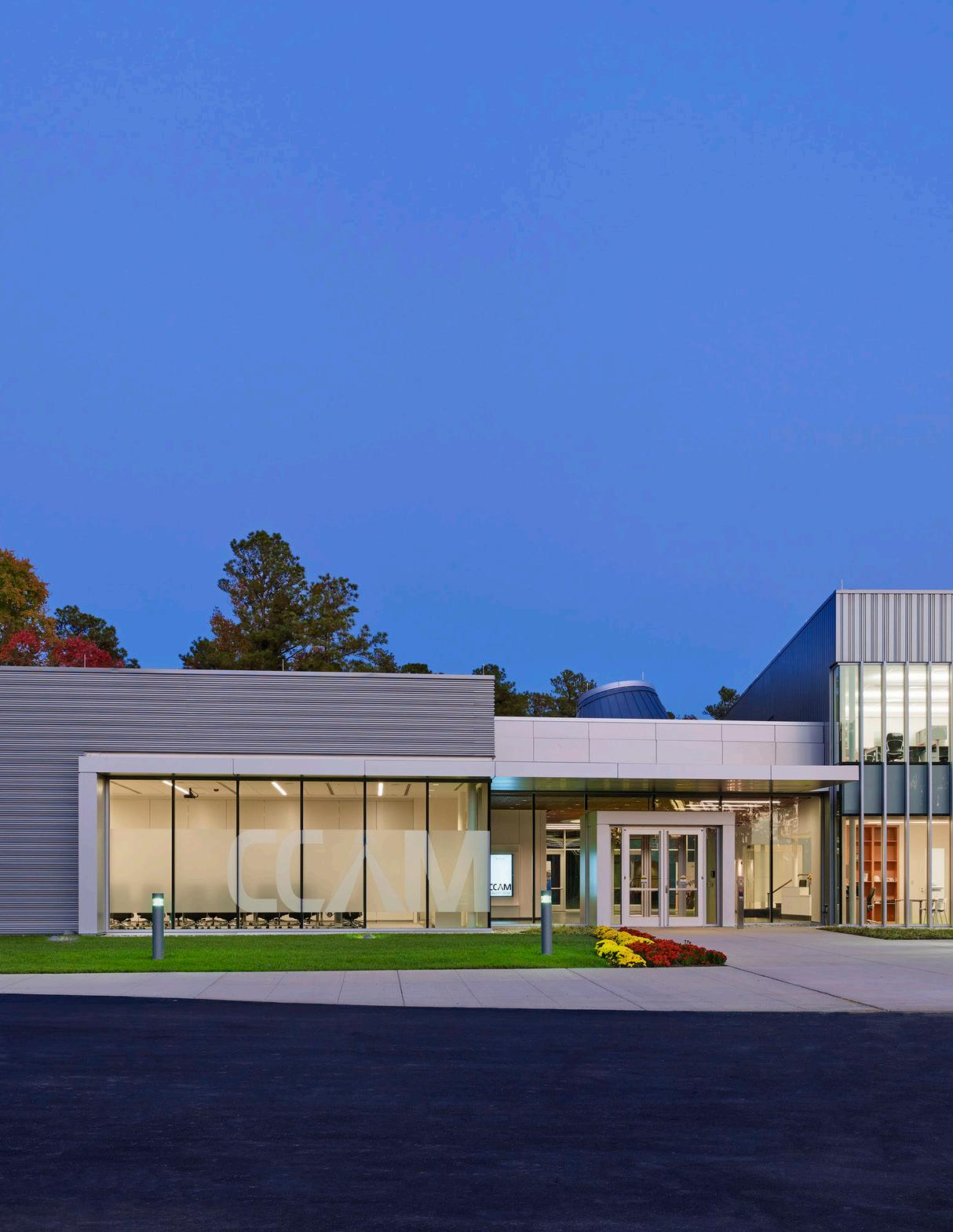

Introduction ― 5
The Technology Innovation Centres: A Brief History ― 9
The Technology Innovation Centres as a Business Proposition ― 19
An Emerging Building Type: Laboratory and Shop Floor Under One Roof ― 25
U.K. Government Policy and Industrial Innovation: The Catapult Concept, and Implications for the United States ― 31
Appendix ― 39
Acknowledgements ― 47

The competitiveness of U.S. high technology manufacturing in the global marketplace is an ongoing topic of political and economic debate.
Meanwhile, while still ranking number one in many measures, U.S. universities see declining trends in research grant funding, and are urgently searching for new models of collaboration with private industry.
One of these new collaborative models has been innovated in the United Kingdom. In the British model, universities and companies commit to becoming dues-paying members in an independent research consortium, equipped with purpose-built facilities to accommodate investigations jointly agreed by the membership. These centers, generally called “Technology Innovation Centres”, each focus on a particular research “theme” that, though specialized, has relevance across a wide range of
aerospace, power systems, electronics, and other technology-intensive industries. The aim of these centers is to accelerate the transition of laboratory discoveries into manufacturing techniques and processes in an environment that has attributes of both laboratory and factory.
In helping the Technology Innovation Centres achieve this goal, a common planning and design approach has evolved which draws from a shared programmatic kit of parts and a consistent strategy for assembling these elements into a coherent architectural statement. In short, we are seeing the emergence of an important new building type.
In late 2009, the University of Virginia Foundation consulted with Perkins&Will to help develop a program brief for a different kind of research facility, a hybrid of laboratory and factory that would offer a new model of collaboration between universities and industry, and would be called the Commonwealth Center for Advanced Manufacturing, or CCAM.
The CCAM initiative envisioned a non-profit institution, housed in a purpose-built facility, which would promote faster and more effective translation of laboratory discoveries into commercializable products and processes.
We worked closely with CCAM’s founding partners—the University of Virginia, Virginia Tech, and the Rolls-Royce Corporation--in programming and eventually designing the new facility; it was my privilege to be the project executive and lead planner in this effort. As the project developed, we were made aware of an important precedent to the CCAM concept – not in this country, but in the British city of Sheffield. The Advanced Manufacturing Research Centre (AMRC) became operational in 2008, and pioneered the model of a membership-based research institution that bridges the gap between laboratory and factory. We also learned that the AMRC would soon be joined by several other “Technology Innovation Centres” (TIC’s) to establish a network of similarly organized facilities, all pursuing complementary themes in materials science and engineering, product development, and manufacturing technology. CCAM will informally associate with these centers, as its primary research themes in surface engineering and manufacturing systems are intended to complement the research efforts of its British cousins.
The the construction of CCAM is nearing completion, with operations expected to begin
in the fall of 2012. As CCAM steadily becomes reality, and as the full array of the British Technology Innovation Centres have recently come on-line, I have set out to gain a deeper understanding of the what the British are doing, and what lessons it may offer for the United States. This study is particularly relevant now, as universities in the U.S. struggle to find new mechanisms for supporting research, in the face of stagnant or declining governmental funding; and high technology industries look for new pathways for innovation, as global competition becomes ever fiercer.
This study aims to provide an understanding of the “British Model” for university-industry collaborative research centers at several levels— development history and government policy; business and operations; and planning and design—by answering the following questions:
• Where is the gap between research and commercialization, and how did certain key universities, private companies, and public agencies come together to bridge this gap with the Technology Innovation Centres?
• How are the organizations of the Centres structured, and how do they conduct the business of research?
• What are the planning and design commonalities—and differences—between the Centres, as well as CCAM? Is this an emerging building type that begins to set a standard for such buildings around the world?
• What is the U.K.’s policy moving forward in supporting these Centres, and enlarging the network and the types of technologies that they address? How does this policy compare to that in the United States?

From exploring the questions above, this study hopes to provide applicable lessons that may empower U.S. universities and companies to collaborate under similar organizational principals as the British Technology Innovation Centres and its new American counterpart, CCAM. This study has new relevance and urgency, as President Obama has recently announced a new initiative, the National Network for Manufacturing Innovation, the ultimate goal of which is to develop a nationwide network of manufacturing research centers, organized along similar principles as CCAM and its British counterparts.
In order to gain a deeper understanding of the British TIC’s, in February 2012, I set out on a tour of the key Technology Innovation Centres that are seen as sister institutions to CCAM. Accompanying me on this trip were Taidg O’Malley, Director of the Perkins+Will London office, and Matt Hall, also from the London office. Together, we visited the various Centres, touring their facilities and conducting interviews with their senior administrative staff as well as with the architects who designed them. Preceding the visits, I had submitted a detailed questionnaire to each of the Centres, which set the agenda of the interviews and facilitated the discussions.

↑ Commonwealth Center for Advanced Manufacturing (CCAM)
The Technology Information Centers: A Brief History
In the world of high-tech industry, somewhere between basic discoveries in the laboratory and full-scale production of profitable and reliable products, lays a graveyard of promising ideas that lacked the right resources for successful translation into commercial reality. Meanwhile, production difficulties plague the manufacturing of high-tech products because problems were not solved at a smaller scale before massive investments in the equipment and processes of commercial-scale production.
The metrics of how basic research evolves into commercializable reality has long been identified, and has developed into such sophisticated rubrics as the Manufacturing Readiness Level (MRL) scale, the Technology Readiness Level (TRL) scale, and its variants. These frameworks describe the attributes of each step along the way as processes are
defined, refined, and scaled up to production levels.MRL 4-6 is the zone of development that institutions such as the British Technology Innovation Centres, and its American counterpart at CCAM, are targeting. They aim to achieve this goal by creating purpose-built facilities where universities and private sector companies can collaborate on shared problems of translating laboratory discoveries into technological innovation.
An important advantage of this model is that the risk of research can be spread amongst multiple members of the centers; another is the enhanced possibility of unexpected discoveries that can occur when members who are coming from very different industries may have a common interest in a certain type of problem, bringing their unique and varied perspectives to solving it.

The Technology Information Centers: A Brief History
Manufacturing Technology Centre, Sheffield
The Technology Information Centers: A Brief History
The centers that are the subject of this study include the aforementioned Advanced Manufacturing Research Centre (AMRC) and its sister facility, the Nuclear AMRC; the Advanced Forming Research Centre (AFRC); the Manufacturing Technology Centre (MTC); the National Composites Centre (NCC); and the Commonwealth Center for Advanced Manufacturing (CCAM).

[AFRC ]ÊÊ AdvancedÊFormingÊResearchÊFacility Glasgow,ÊScotland
Location Map of British Manufacturing Readiness

[AMRC ]ÊÊ AdvancedÊManufacturingÊResearchÊFacility Sheffield,ÊEngland


[MTC ]ÊÊ ManufacturingÊTechnologyÊCentre Coventry,ÊEngland

[NCC ]ÊÊ NationalÊCompositeÊCentre Bristol,ÊEngland
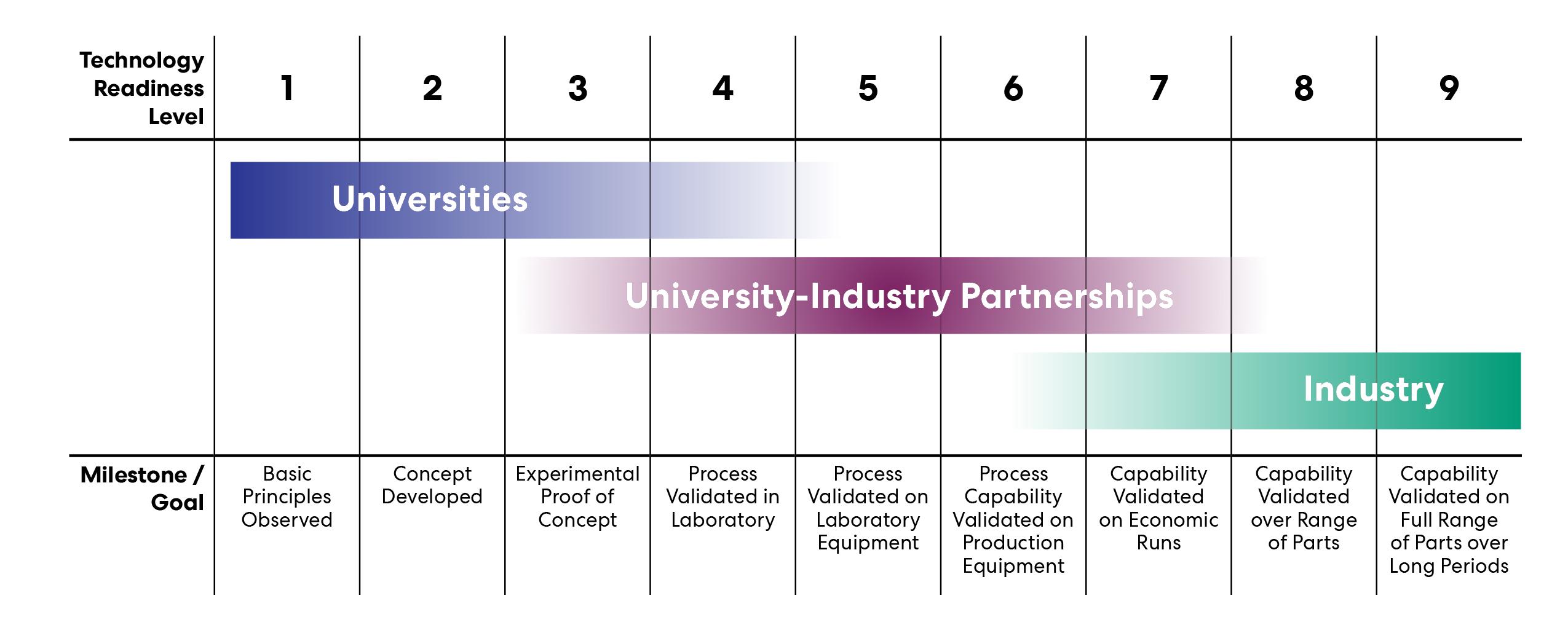
LONDON
Advanced
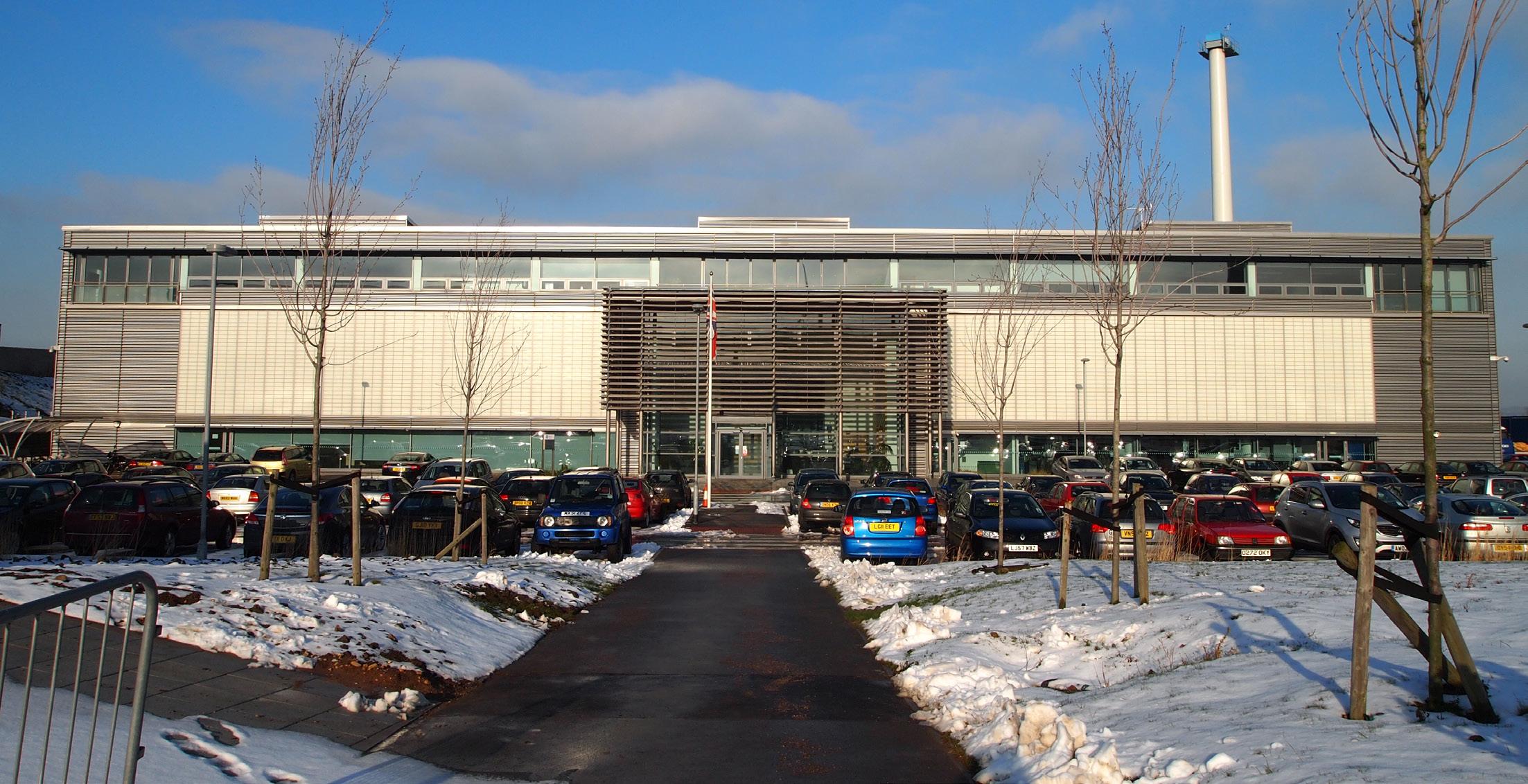
At the beginning of this century, on a reclaimed brownfield near the city of Sheffield, England, a novel experiment began in how universities and industries could collaborate in manufacturing research. The Boeing Corporation sought new breakthroughs in machining technology; the University of Sheffield was particularly renowned in research in machining and metallurgy, owing to centuries of expertise that made the Sheffield region famous for metalworking. Boeing and the University partnered in the traditional way in the 1990’s, with Boeing directly funding research projects, but in 2001, set out in an ambitious new direction. Working at a larger political scale, and gaining funding and support from regional development agencies (Yorkshire Forward) as well as the European Union (European Regional Development Fund), the founding partners created the Advanced Manufacturing Research Centre (AMRC), a new institution that would be housed in a purpose-built facility where multiple industrial companies and the University could collaborate on projects within the general theme of machining technology.
The organizational breakthrough was the membership model: participants would be members of a research “club”, paying annual dues that would cover the operational costs of the Centre. All research conducted at the Centre would fall into one of two categories: “generic” (projects of common interest amongst the various members, funded by the membership dues) or “directed” (projects of particular interest to a particular member or subset of members, funded by the participants). Another key aspect to the model would be the disposition of intellectual property (IP): all members would share in the IP resulting from generic research, while the results of directed research would become the IP of the particular sponsors. This approach to intellectual property within a collaborative environment ensures both continued interest in shared research but also incentivizes investments in directed research, which – as will be discussed further – is a key to the financial success of the Centre.
Manufacturing Research Centre (AMRC)
↑ AMRC “Factory of the Future”
Advanced Manufacturing Research Centre (AMRC)
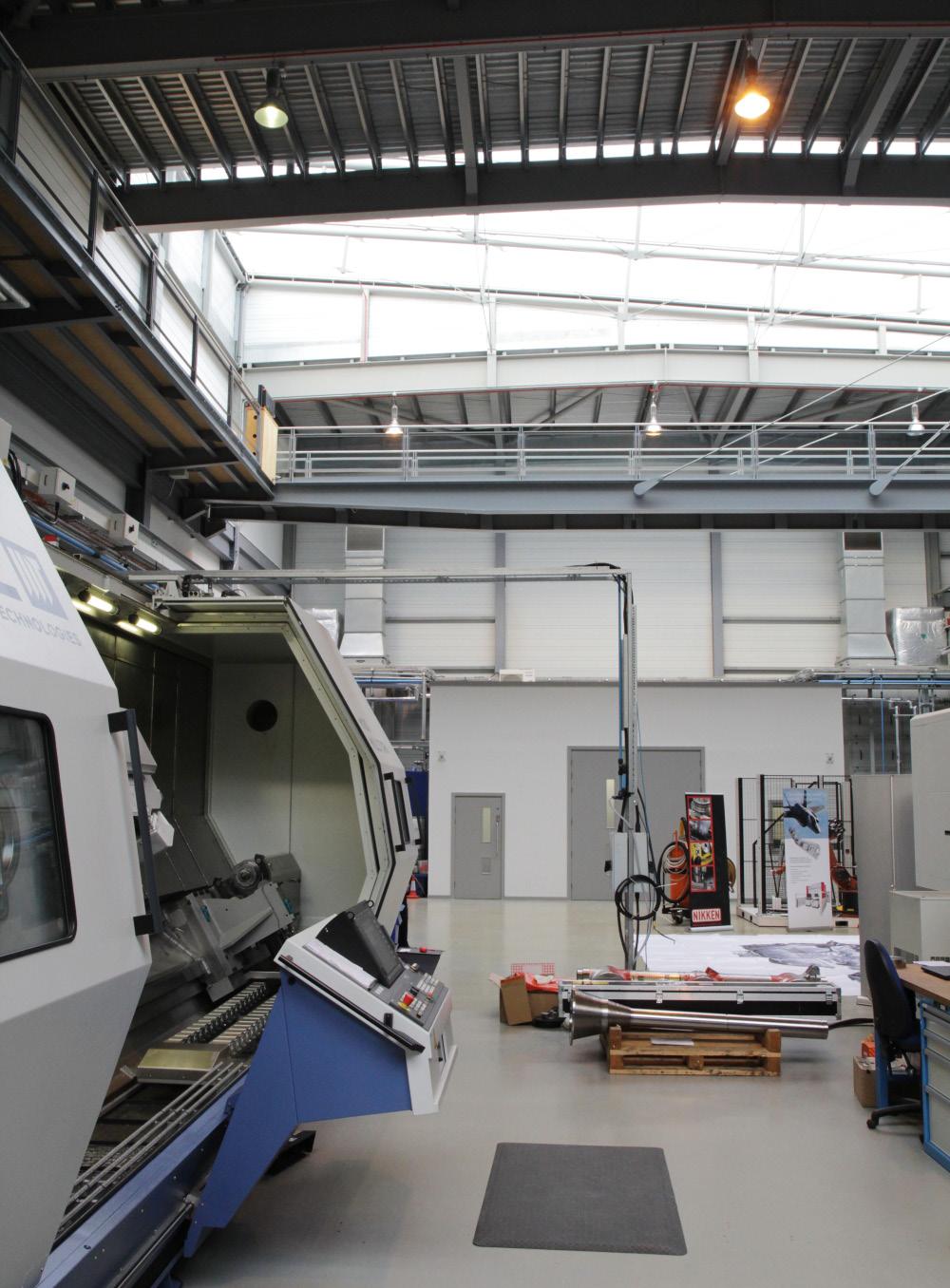
The AMRC completed its initial 1200 m2 (13,000 sf) facility in 2004, on the reclaimed site of a former coking works just outside of Sheffield. Very quickly, the increasing roster of members and projects began to outgrow this modest first building. About that time, Rolls Royce, as a member of AMRC, championed the development of a much larger facility, dubbed the “Factory of the Future”, that would more capably support the potential of the AMRC model.
Understanding the level of ambition for this project, the members carefully set the vision and goals for the facility, an effort that included a charrette facilitated by the Rocky Mountain Institute. These visioning sessions determined functional requirements for the building, the workplace culture that the building should facilitate, and the sustainability attributes that the building should have. The programming effort pointed towards a building

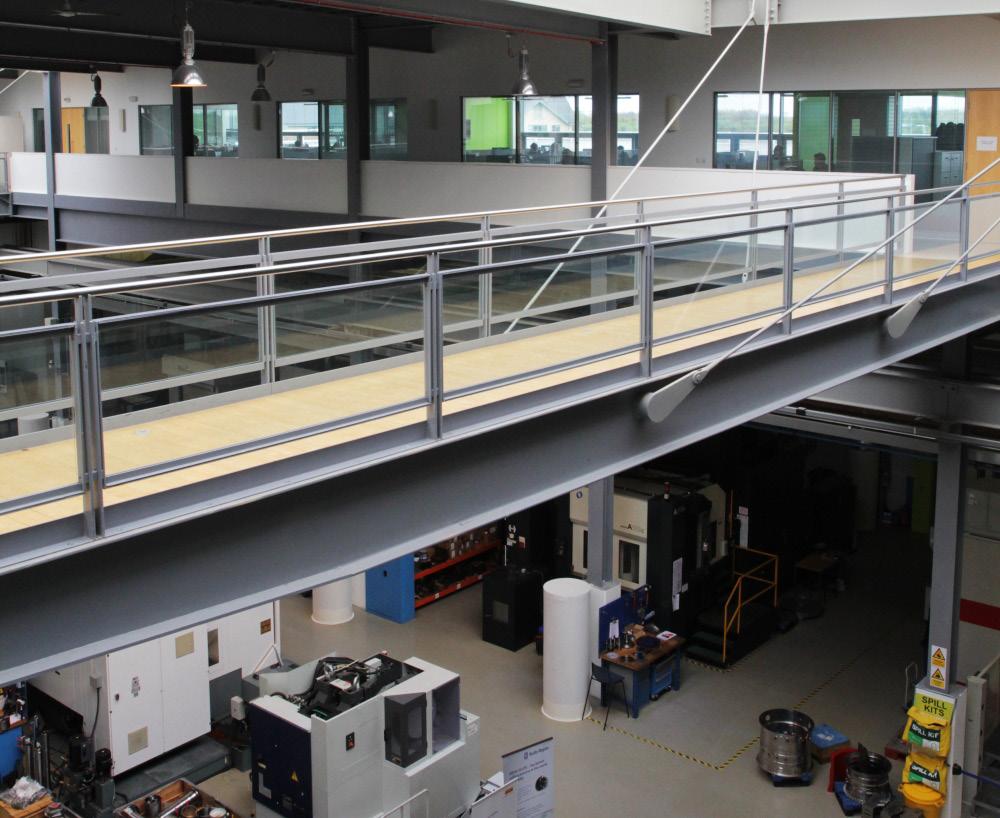
almost four times the size of the original, at 4,500 m2 (48,500 sf).
The functional realities of collaborative research in machining technology demanded a very large high bay space; the relatively small available site area suggested that any program areas that did not need to be on slab-on-grade—that is to say, virtually everything besides the high bay, certain specialty laboratories, and the entrance lobby— needed to be elevated. The solution was “the office over the workshop”—all the office and meeting areas are on top of the high bay, resulting in the equivalent of a 3 story building. Acknowledging the functional demands, and honoring the idea of “factory” as a theme for the project, Bond Bryan Architects embraced a simple, rectangular box as the outward form of the building, but developed it with great sophistication in its detailing.
AMRC office area
AMRC high bay; Bridge linking office area to meeting area, over high bay
Advanced Manufacturing Research Centre (AMRC)
The founders desired a workplace culture that would reflect and support the collaborative mission of the Centre; the design supports this goal by an open and airy office floor with a flexible workstation environment interspersed with glass-walled team meeting rooms (there are very few private offices). At the same level, on the other side of the high bay, is a conference area with meeting rooms of various sizes as well as the main employee canteen. Connecting the office and the meeting areas are bridges that cross over the high bay, which, together with generously large windows from offices and meeting rooms that look down into the space, visually link the activities on the office level (computational research, analysis, administration, meeting) with the “factory floor”, where research is applied in actual processes with real factory equipment.
The theme that links the functional and cultural goals of the project is sustainability, which was a very high priority from the inception of the project. Features include ground source heat
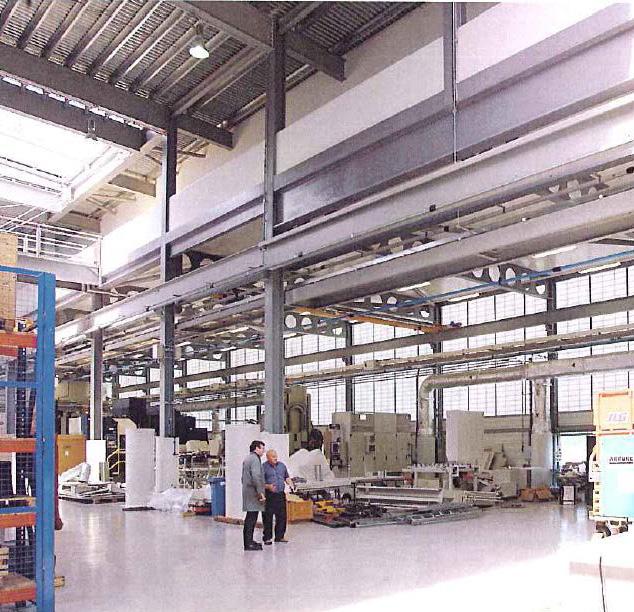
pumps, and effective daylighting strategies (Buro Happold confirmed 98% of the floor area is naturally lit), natural ventilation in most areas, and solar shading. Most iconic is an 86 meter wind turbine, which offsets approximately one third of the building’s annual electricity usage. The building was awarded the highest BREEAM rating, “Excellent”.
Opened in 2008, the AMRC “Factory of the Future” is a showcase building in at least three ways – as a venue for putting the latest technologies in machining processes on display for the large number of visitors who tour the building every year, as an architectural expression of “industrial elegance” that pays homage both to its factory roots as well as to the progressive goals its mission, and, finally, as a demonstration that industrial progress and sustainability are not necessarily contradictory goals.
Despite moving into much larger facilities in 2008, the AMRC quickly filled with new projects and additional member companies, as well as new research topics beyond the founding theme of machining technologies. Meanwhile, member companies were reporting, at least anecdotally, significant benefits of their memberships. For example, Aero Engine Controls reported a £600,000 benefit from a £40,000 investment in membership. Rolls-Royce reported machining cycle time reductions of up to 80%. The membership roster increased to over 60 member companies.
AMRC high bay
Advanced
Recognizing the success of AMRC, other partnerships of regional development agencies, universities, and high-technology companies (many of whom were already members of AMRC) began initiating projects modeled after AMRC. The first of these was the Advanced Forming Research Centre in Glasgow, Scotland. The synergy here was the strength of the University of Strathclyde in metallurgy and manufacturing technology (a talent that draws from Glasgow’s historic leadership in shipbuilding and other heavy industries), and the innovations sought after by Rolls-Royce, Boeing, Mettis, and other companies having an interest in forging and forming of precision components for critical applications in diverse fields such as aerospace, marine propulsion, and oil exploration.
Like AMRC, the third leg of the stool was participation by a regional development agency, in this case, Scottish Enterprise. With their commitment of public funds for the construction and the initial equipment, the AFRC project could move forward, beginning with the development of the functional program in 2008 (about the time the AMRC Factory of the Future was coming on-line).

Although the research theme was different, the functional considerations for the AFRC were broadly similar to those at Sheffield: a high bay where very large tools and equipment could be moved with relative ease; laboratories that could support sensitive specialty activities such as surface characterization and metrology; and an open, flexible office environment. However, program and budget pointed to a building only approximately half the size of its sister facility in Sheffield, on a larger site—thus, a singlestory solution made the most sense. Hypostyle
Architects, of Glasgow, gave the building a memorable form by bifurcating the building with a central “street” feature that functions as entrance lobby and break-out space from adjacent meeting rooms, and (using some specifically aeronautic imagery for inspiration and deliberately avoiding the appearance of a box) endowed the office and high bay zones with expressed shed roofs that are as striking on the exterior as they are on the interior.
Sustainable features included enhanced air tightness and insulation in the exterior envelope, maximization of natural light and natural ventilation, and sophisticated energy control systems. The project achieved a BREEAM “Very Good” rating. The AFRC opened its doors in the summer of 2010.
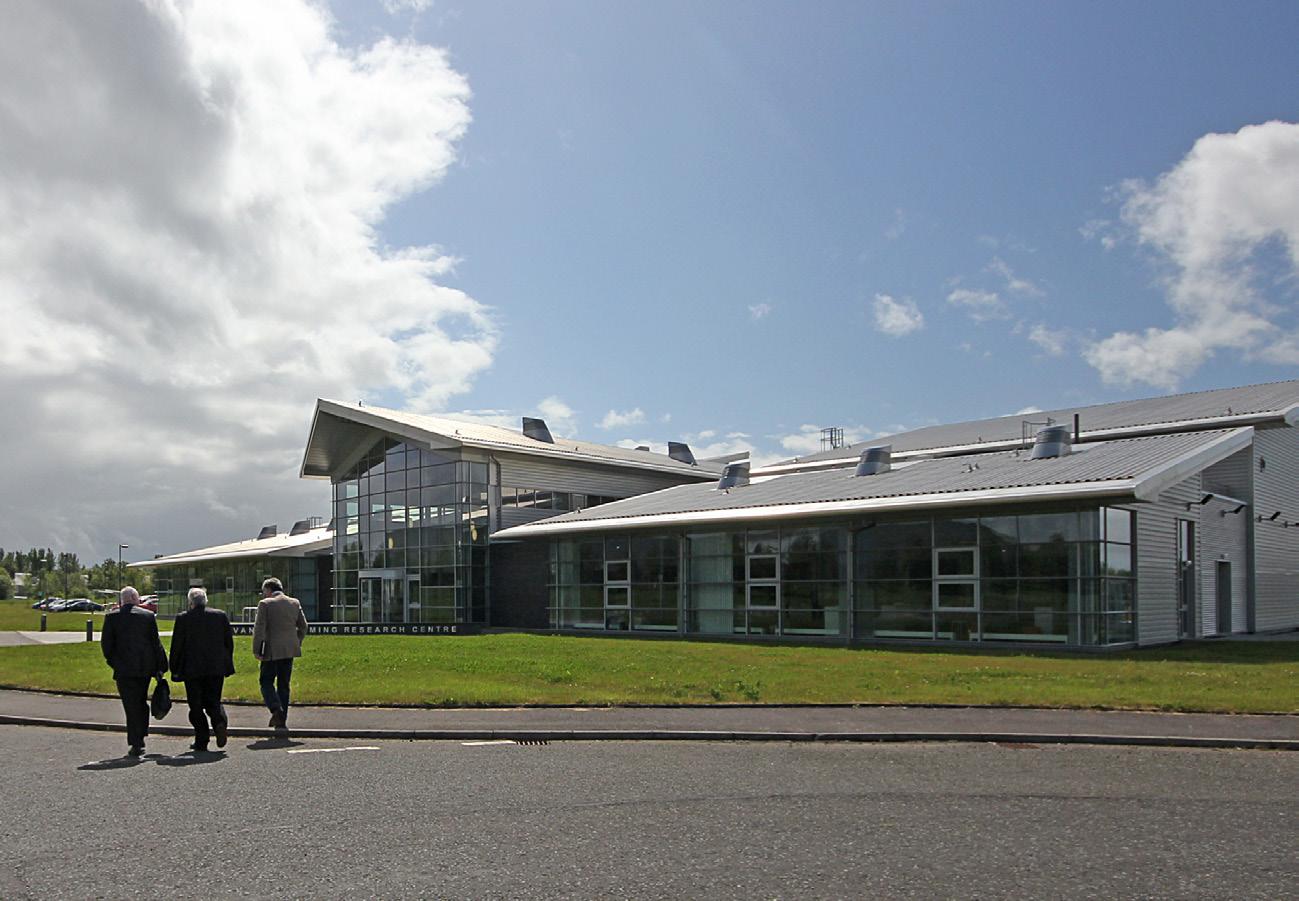
Forming Research Centre (AFRC)

Certain key industrial members of the the TIC’s in the UK recognized, given the nature of their global supply chains, the importance of expanding the TIC model to other countries, including the United States. Building on particular strengths of the affiliated universities, University of Virginia and Virginia Tech, the new center in the U.S. would have a theme that none of the U.K. centers had yet emphasized: surface engineering, a specialty in materials science that pertains to coatings and other surface manipulations of materials that alter their fundamental properties. This center, called the Commonwealth Center for Advanced Manufacturing (CCAM), would be located near Petersburg, Virginia, not far from the recenty completed Rolls Royce factory that manufactures jet engine disks.
CCAM had its first programming effort in the fall of 2009; the project was completed in October of 2012. This 62,000 sf facility has a similar mix of basic program components as has been described for the AMRC and its cousins; but, in organizational strategy, more closely resembles the AFRC (the diagrams
in the latter part of this study illustrate the relationship). Drawing on reported lessons from the operational life of the AMRC, a deliberate visitor pathway (“parade route”) is hard-wired into the planning of the building. Like the NCC, the design offers plenty of closed-wall laboratory spaces to accommodate processes that will need unique environmental conditions, a consequence of the surface engineering research theme. Like the MTC, a generously sized lobby that offers independent access to a dedicated conference area anticipates the center as a busy venue for meetings, seminars, and presentations.
As its roster of members grows, and specific research projects are identified, CCAM regularly communicates with its cousins across the Atlantic. And during this time, yet another similar center is in design in Singapore, the Advanced Remanufacturing Technology Centre. The ARTC will fill yet another niche, finding new techniques and processes for extending the life of critical components rather than making them from scratch.
Commonwealth Center for Advanced Manufacturing (CCAM)
↑ CCAM West Exterior (all photographs by Alan Karchmer)
Commonwealth Center for Advanced Manufacturing (CCAM)
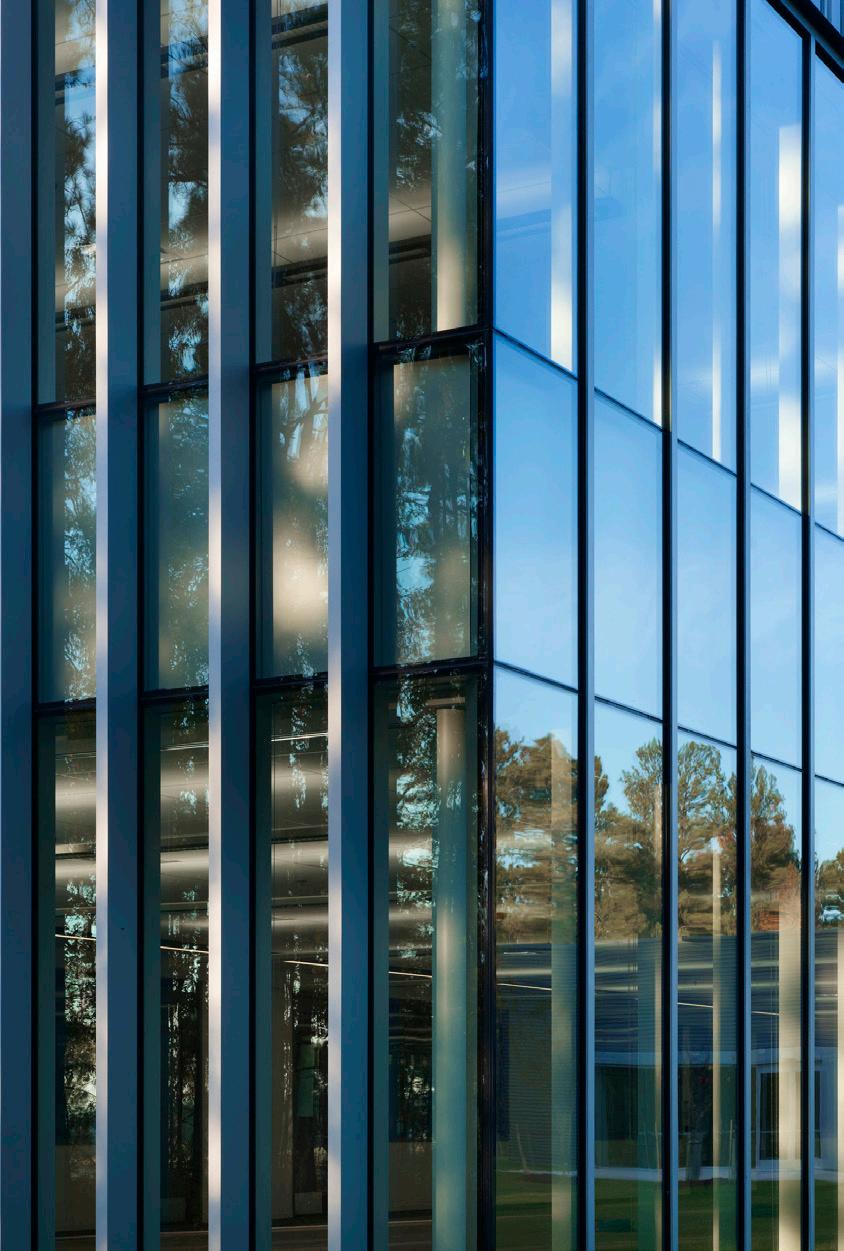


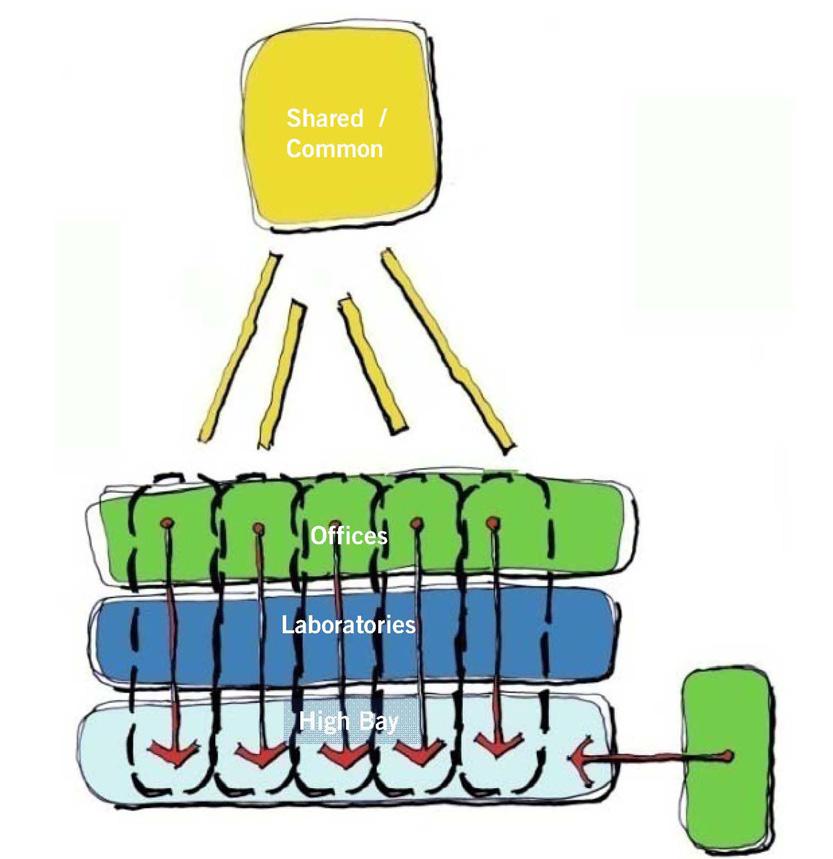
Diagram
CCAM High Bay
The Technology Information Centers as a Business Proposition
The Technology Innovation Centers as a Business Proposition
The TIC’s, along with their American cousin CCAM, share the same basic organizational scheme that was established at AMRC in Sheffield. In summary: private sector companies are dues-paying members of a non-for-profit research organization; this organization is affiliated with one or more research universities; and, most critically, the member companies share in ownership of the intellectual property that results from generic research projects.
All of the centers have at least two tiers of membership. Members at the top level typically pay between £200,000 and £300,000 in annual dues ($320,000 - $475,000). These members are typically large, well-established Original Equipment Manufacturers (OEMs) with a wide range of technological interests. Their membership includes a seat on the board of directors, which, besides having oversight on the operations of the center, also determines which projects will be pursued as generic research. These Tier I members share in the ownership of the intellectual property (IP) stemming from the generic research.
Second (and in some cases, third) tier memberships are generally aimed at smaller companies, or companies whose interests are focused on a single area of technology. Benefits for the lower tier members are correspondingly more limited; for example, they may not share in the IP of generic research outside of their particular project involvement.
Members typically must commit to a minimum time duration for their membership, for example 5 years for Tier I, 3 years for Tier II, etc. In some cases, a member may provide in-kind donations, such as major equipment, to satisfy its dues to the center in whole or in part.
Major OEM’s such as Boeing, Airbus, and RollsRoyce were major players in the establishment of the centers; however, beyond the founding members, a center’s financial success relies on
having a critical mass of Tier I members. Thus, recruitment is a critical activity, particularly in the first few years of a center’s existence. While many members consist of companies with an aerospace focus, the research themes tend to cut across all industries that rely on innovations in materials science and engineering and their related manufacturing technologies. Thus, the membership profiles of the centers can be rather ecumenical: besides aerospace, members are coming from fields as diverse as electronics, imaging, medical equipment, robotics, industrial tooling, and power generation, to name a few.
The founding of all of the Technology Innovation Centers had roots in existing relationships between certain major OEMs and particular universities. For example, Boeing’s collaboration with the University of Sheffield, building upon that university’s noted accomplishments in machining technology, paved the way for the establishment of the AMRC. In some cases, the relationship can be with multiple universities – for example, with its multi-themed research agenda, the MTC involves a consortium of universities in the East Midlands region, each bringing different talents to the Centre, including the University of Birmingham (net shape manufacturing), the University of Nottingham (advanced tooling), and Loughborough University (electronics manufacturing).
The structural relationship between the universities and the centers is variable. In some cases, the Centre is a wholly owned subsidiary of its affiliated university (as is the case with the AMRC and the University of Sheffield). The MTC, on the other hand, is an independent non-profit corporation (in the U.K., a “Company Limited by Guarantee”, roughly equivalent to a 501(c) organization in the United States).
The Technology Innovation Centers as a Business Proposition
AMRC established the concept that collaborative and proprietary research could co-exist in the same institution. In fact, the business model depends on the additional revenue that proprietary research brings, in addition to the annual dues paid by the members. As mentioned previously, “generic” research are those projects jointly agreed by the top-tier members to be of interest to all; the cost of this research is part of the operating expenses of the center; and the intellectual property accrues to all the top-tier members.
“Directed” research are those projects commissioned by an individual member, or group of members, who pay additional fees for the research, and enjoy exclusive rights to the I.P. Similarly, an entity completely outside the membership of a center may commission research, and pay fees to the center for this effort.
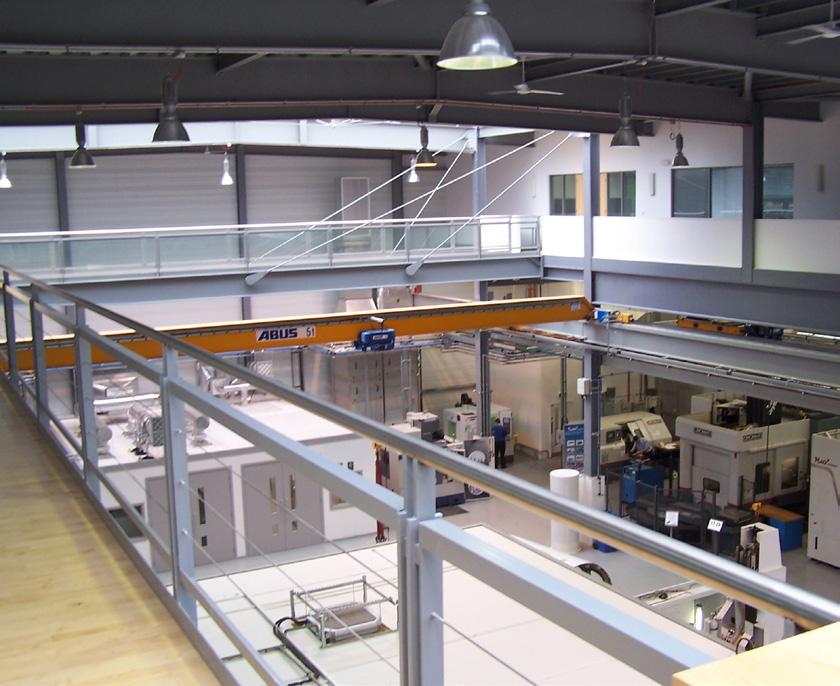
Directed and commissioned research are a substantial revenue stream for all the centers, and can comprise anywhere from 50% to 80% of the research volume at the centers.
The presence of proprietary research poses a dilemma in buildings that are otherwise intended to be hotbeds of collaboration, with physical transparency as an architectural goal across all the centers. However, the centers seem to have had few challenges in being able to create necessary security –physical and or visual – in certain areas where particularly sensitive work is in progress. Occasionally, a “room-within-a-room” may be constructed to provide the necessary barrier. More challenging, in some cases, has been the setting up of the information technology infrastructure in the buildings to allow secure data to be handled and stored within what is otherwise a collaborative network.
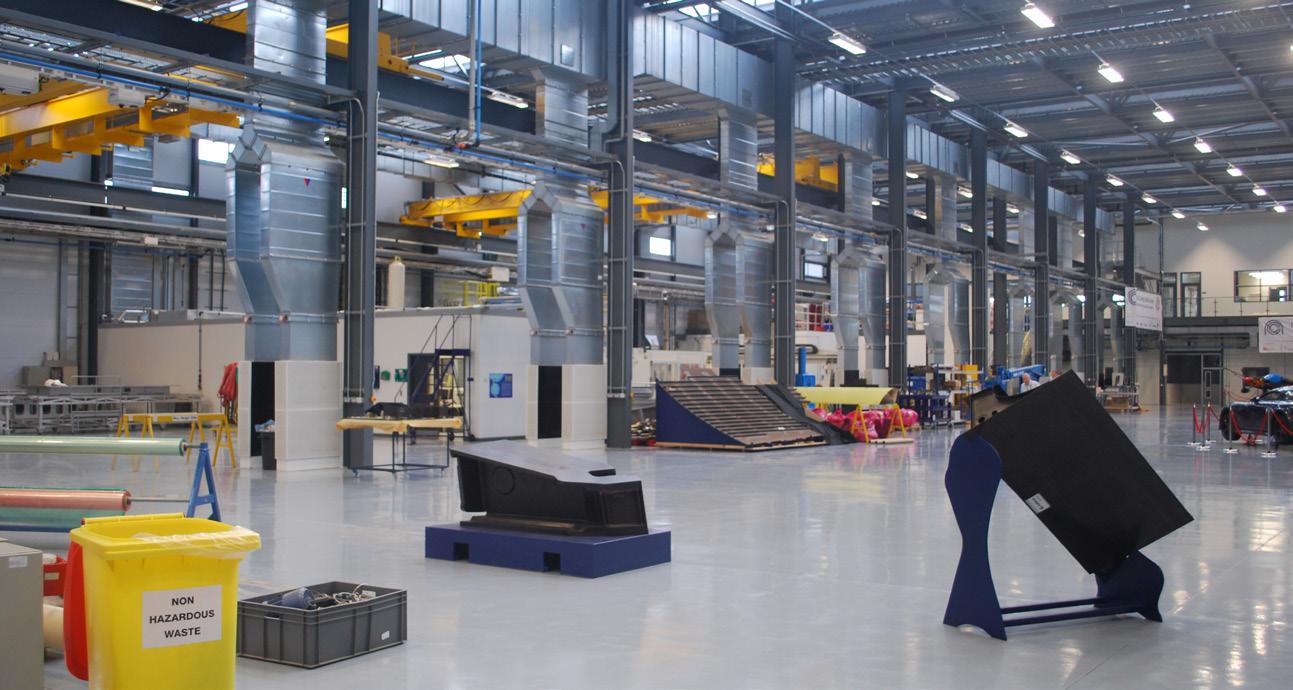
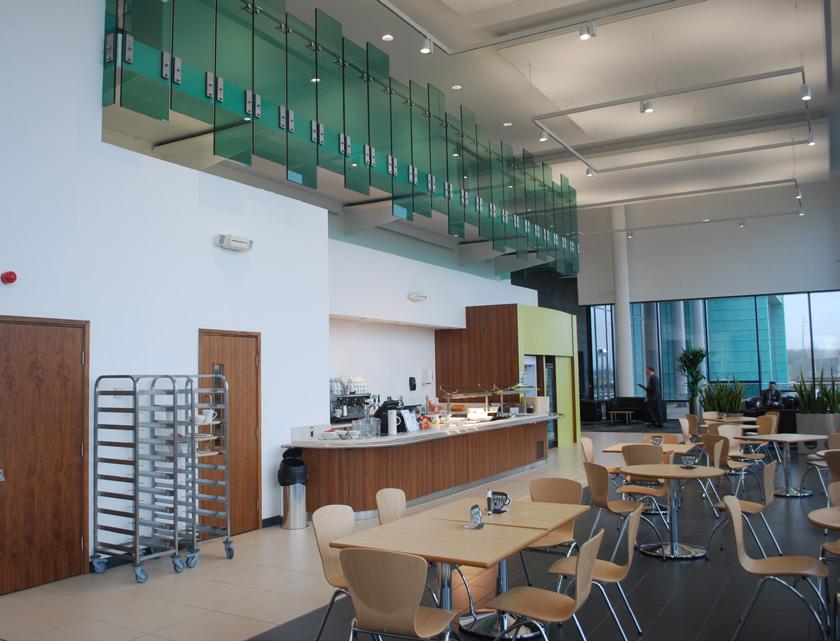

National Composite Centre, High Bay (top); AFRC Office Space (bottom) ↓
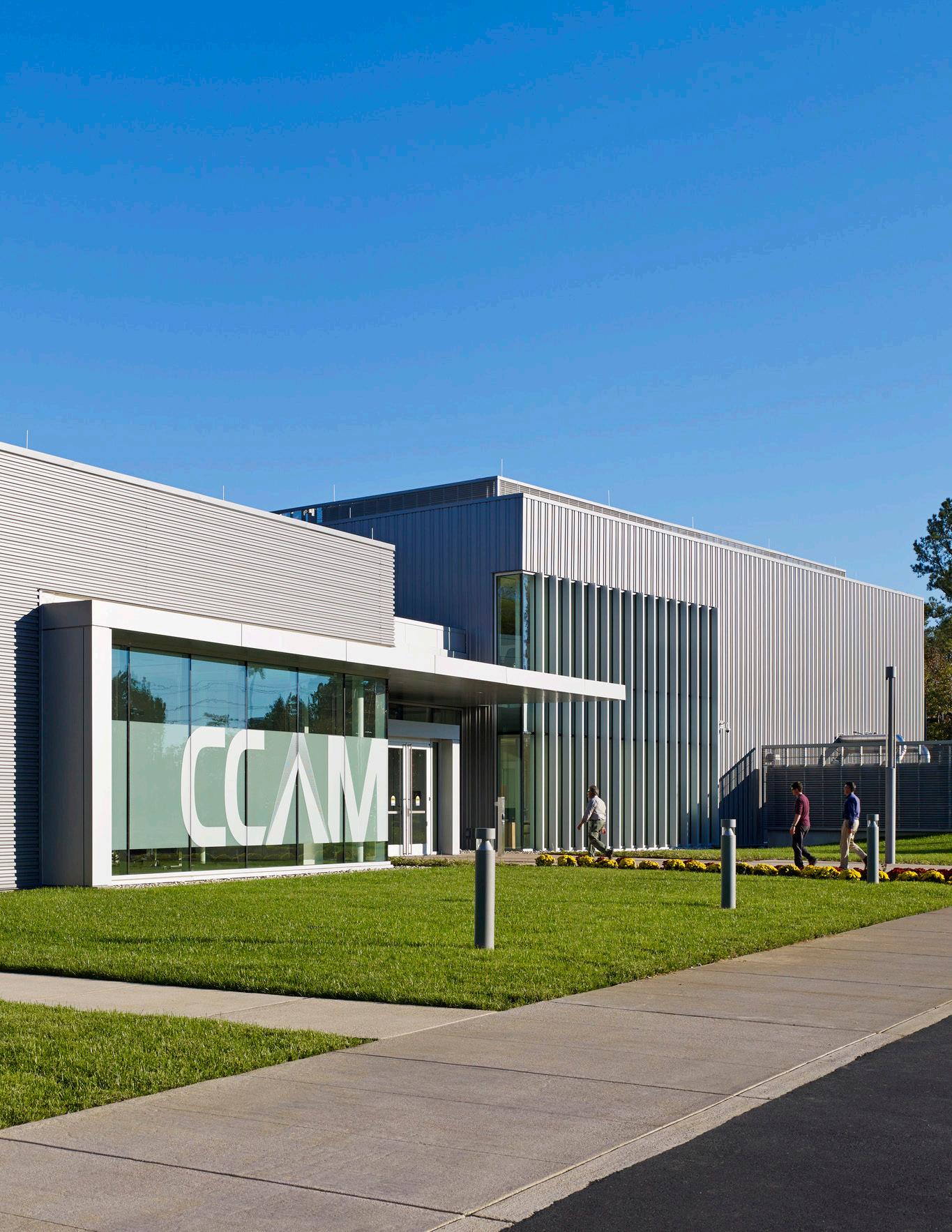
The Technology Innovation Centers as a Business Proposition
Location Sheffield, England, U.K.
Building Owner
Glasgow, Scotland, U.K.
University of Sheffield Strathclyde University
Coventry, England, U.K.
Manufacturing Technology Centre, Ltd.
Bristol, England, U.K.
University of Bristol
Petersburg, Virginia, U.S.A.
University of Virginia Foundation
Construction Cost (2012, in U.S. $, ($1.60/£)
Building Gross
(m2)
Public Funding of Construction Cost
(Yorkshire Forward RDA, European Union)
(Scottish Enterprise)
University Members University of Sheffield University of Stratchclyde
• Machining & Milling • Composites
Research Themes
• Forming
• Forging
• Tool design
(East Midlands Development Agency, Advantage West Midlands)
University of Birmingham, University of Nottingham, Loughborough University
• High integrity fabrication
• Net shape
• Intelligent automation
• Tooling
(Southwest RDA, European Union)
(U.S. Economic Development Agency)
University of Bristol
University of Virginia, Virginia Tech, Virginia State University
• Manufacturing simulation & informatics • Composites manufacturing • Preform technologies • Surface engineering & coatings • Manufacturing systems Ratio of Generic to Directed Research
Technology Innovation Centres - Comparison at a
NOTE: Adjusted construction cost based on Faithful & Gould Construction Inflation Reports of March 2010, April 2011, and October 2011, reflecting annual construction cost deflation/inflation of -10% in 2009, -3% in 2010, and +2% in 2011.
An Emerging Building Type: Laboratory and Shop Floor Under One Roof
An
Although these five technology Innovation Centres were designed by separate architectural firms, with limited awareness of each other while the program briefs and designs were being developed, it is remarkable how a comparison of the centers reveals many more similarities than differences. Partially, this is a result of the example set by the AMRC. It is also a result of all firms embracing the functional logic of the building as a giver of form, and of having separately arrived at a common set of goals.
The high bay (or bays) are the most critical program element, needing at once to be both like a true factory floor but also not setting up obstacles for change. Once set up, a factory floor may remain unchanged for many years; in a research environment such as at these centers, large equipment gets moved in, moved around, and moved out with much higher frequency. Thus, the high bays generally feature large undifferentiated floor space with at least 8m overhead clearance, large access doors from the exterior, generous daylighting, a modular approach to delivering utilities, and (in most cases) a very strong floor slab capable of supporting extremely heavy equipment. Most of the high bay spaces in these centers are equipped with traveling bridge cranes.
Laboratory spaces supplement the high bays, providing enclosed environments for

specialty and sensitive work that requires acoustic separation from the generally noisier high bay, or that have unique environmental requirements. Mechanical systems serving high bays generally recycle some proportion of the high bay air, and these spaces can have a relatively large range of temperature and humidity. But sensitive instrumentation and activities such as metrology (precision measuring), surface characterization (involving very sensitive tools such as scanning electron microscopes), metallurgy, chemistry, and many other specialty activities usually require air systems meeting laboratory criteria in terms of temperature and humidity range, air change rate, and ability to handle heat loads. In these spaces, all air once exhausted from the lab is not recycled.
Office areas are open plan; private offices are very rare. A variety of teaming and meeting spaces are distributed in the office areas to provide venues for collaborative project work. In all cases, open workstation areas are positioned to allow views into the high bay area, or the labs, or both.
In the U.K., conditioned air and power and data cabling are provided by a raised flooring system, thus allowing higher ceiling heights and advantages in energy efficiency.
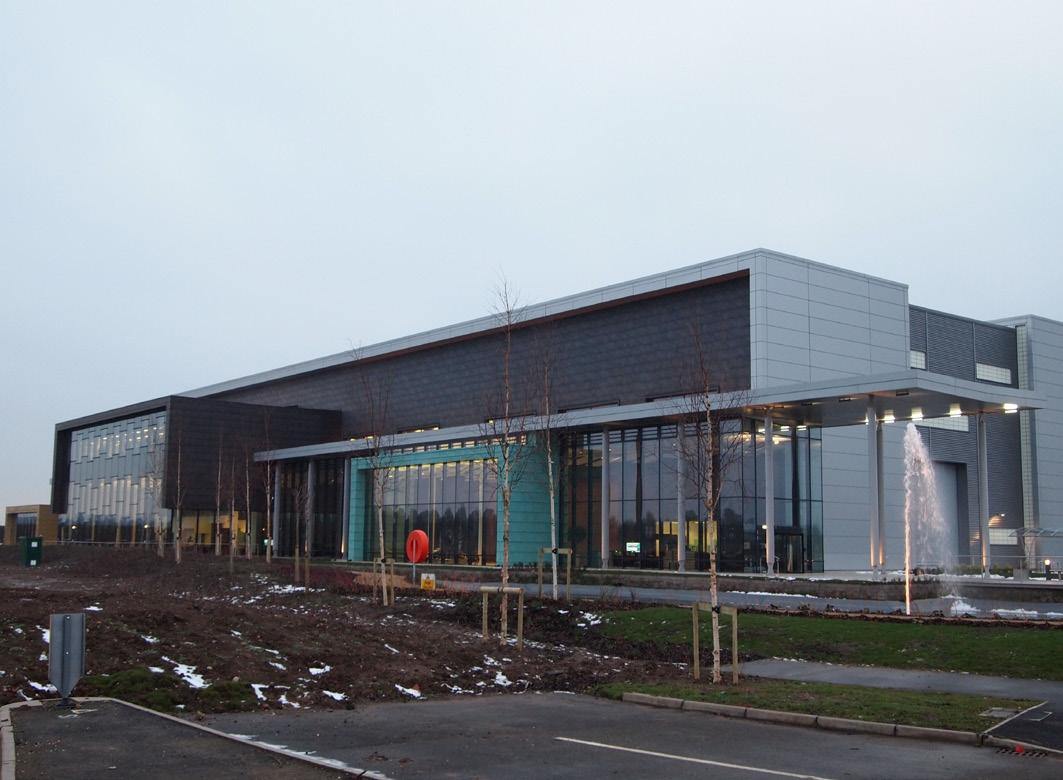
Emerging Building Type: Laboratory and Shop Floor Under One Roof
MTC High Bay Exterior (left); MTC Public Exterior (right) ↓
An Emerging Building Type: Laboratory and
Shop Floor Under One Roof
In most of the centers, some of the large meeting rooms are separated from the office areas and are more directly connected to the building lobby. Together with the lobby, which serves as break-out space, these meeting rooms create a miniature conference venue for lectures, seminars, and symposia that have become commonplace in the centers.
All of the centers recognized that despite the very practical and functional imperatives of these buildings, the image of the building and the visitor’s experience would be critical for successfully conveying the mission of the centers to the broader public. This was recognized at the AMRC, but even they did not anticipate the volume of visitor traffic that would eventually be flowing through their facility. The designers of the subsequent centers took this lesson to heart, carving out more generous lobby spaces and sometimes incorporating “parade routes”, i.e., designated walking routes that choregraph the experience of typical visitors who are escorted through the building.
In every case, the founding partners of the various centers requested their designers to develop an “iconographic” image of the building, recognizing the importance of these new institutions in their literal as well as
political landscapes. The designers, including Perkins+Will at CCAM, found an architectural voice that while unique to each center, were all within a certain bandwidth of formal simplicity and what one might call “industrial elegance”.
Finally, as mentioned in the individual descriptions of the centers in Part II, all of these projects recognized the resonance between sustainability and fundamental goals of the research that the centers are meant to support: striving for manufacturing techniques and processes that are more efficient, less energy intensive, and less wasteful of materials. To that end, all of the projects employed an array of energy efficiency strategies, some of which were imaginatively leveraged into becoming a part of the building image (for example, the wind turbine at AMRC, or the serrated profile of the clerestory windows at the NCC). All of the U.K. projects achieved either of the top two ratings available under the BREEAM system.
Together, as the following diagrams and floor plan comparisons show, the Technology Innovation Centres have invented what is essentially a new building type, not quite resembling a typical engineering lab at a University, nor a factory either, but something that, quite appropriate to the research it supports, somewhere between the two.


NCC Service Yard (left); AMRC in Foreground; Nuclear AMRC in Background (right) ↓
An Emerging Building Type: Laboratory and Shop Floor Under One Roof
High Bay Heavy Equipment Labs
Securable Enclosed Labs
Open Workstation Environment
Enclosed Teaming, Meeting or Seminar Rooms; Cafe
Circulation and/or Display/Exhibit Area
Core and Support Areas


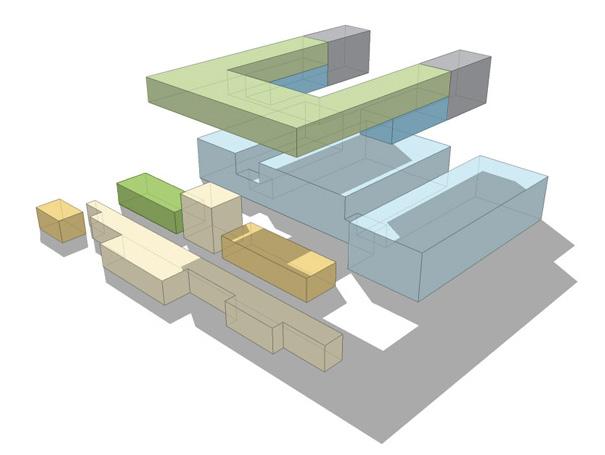
Figure 1
Figure 2
Figure 3
An
Emerging Building Type: Laboratory and Shop Floor Under One Roof
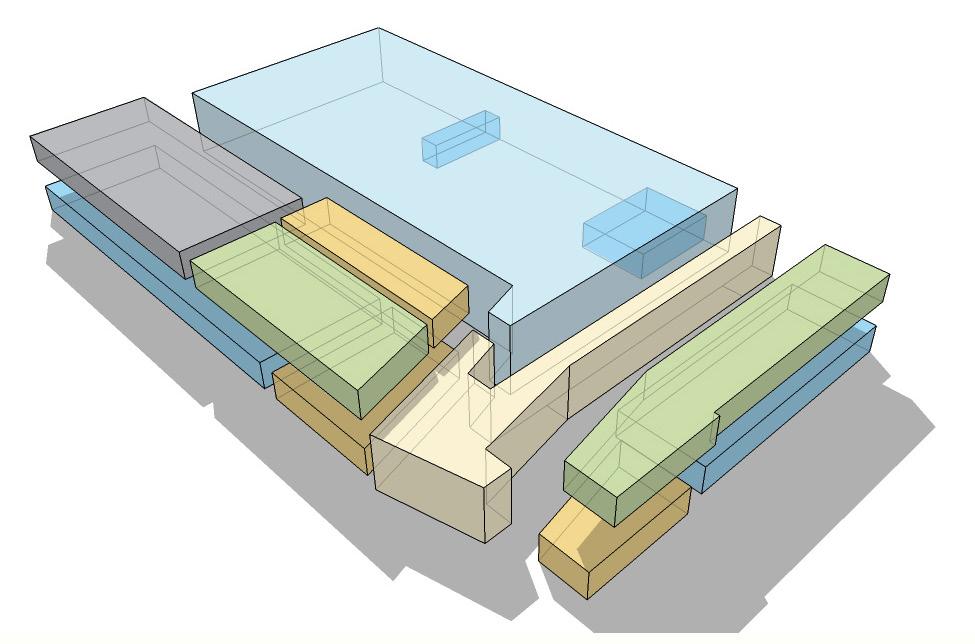
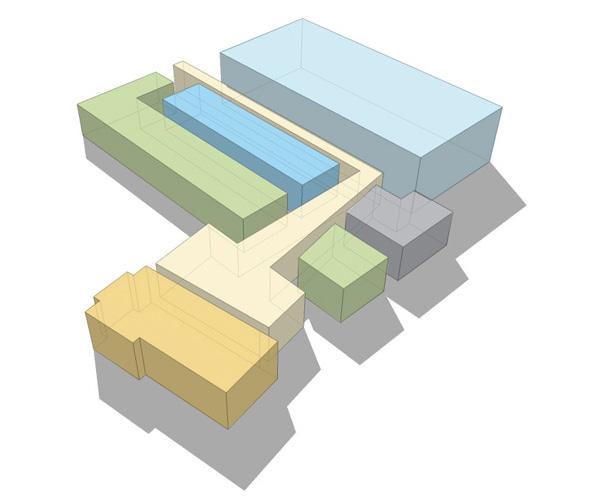
Figures 1-5: Technology Innovation Centres Stacking Diagrams and Program Comparison Charts
Figure 6 (Below): TIC Program Chart Average
Figure 4
U.K. Government Policy and Industrial Innovation: The Catapult Concept, and Implications for the United States
the U.K.
As the birthplace of the Industrial Revolution, invention has a special place in the cultural DNA of the British Isles. So, too, does the making of things that are the fruit of this inventive spirit. Together, these instincts built a prosperous manufacturing economy that earned Britain, by the late 19th Century, the sobriquet “workshop of the world”, well more than a century before that phrase became associated with China.
However, recent years have seen a decline of the UK’s share of manufacturing in the world economy, as summarized in the following points extracted from the House of Commons Library report International Comparisons of Manufacturing Output (updated January 2012).
“As of 2010, the UK ranked:
• 9th in terms of manufacturing output (value added) at $231 billion, behind the USA, China, Japan, Germany, Italy and France. The UK was between 5th and 8th on this list in the entire period since 1970.
• 33rd in terms of manufacturing output per head (around $3,700), behind most major developed countries.
• 108th in terms of manufacturing output as a share of gross value added (11%), marginally ahead of France.”

While statistical evidence was piling up that the U.K.’s competitive world advantage in manufacturing was beginning to erode, particularly in the high-value, high-technology industries that had been its traditional strength, there was attendant concern that shifting the economy more towards financial and service industries would not realistically solve long-term unemployment problems. As Lord Mandelson, Business, Innovation and Skills Secretary in the Labour governments of Tony Blair and Gordon Brown, remarked in late 2009, the UK needed “less financial engineering and more real engineering”, recognizing that broad-based prosperity could not be achieved without a healthy, growing manufacturing sector.
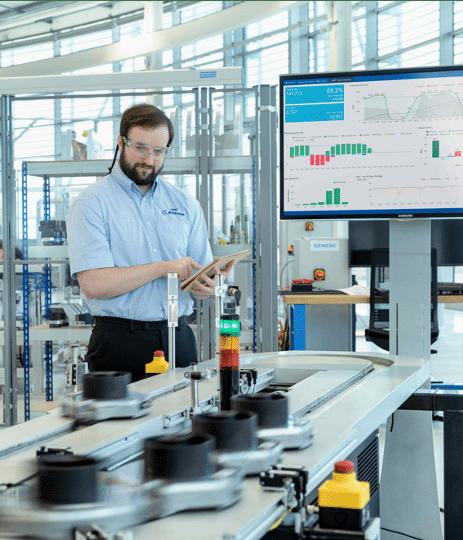
The Rise, Fall, and Recovery of Manufacturing in
Members of the
AFRC Rotary Friction Welding team
Aerospace advanced manufacturing at AMRC
Diagnosing the Problem: The Hauser and Dyson Reports
Earlier in 2009, Lord Mandelson had commissioned a report to identify what the U.K. could be doing better to compete more effectively in high-value manufacturing. Dr. Hermann Hauser, a noted entrepreneur and venture capitalist in Britain, was asked to lead the effort; the resulting report, The Current and Future Role of Technology and Innovation Centres in the UK, focused on research and development as the key area needing improvement. Dr. Hauser succinctly framed the global competitiveness situation:
“. . . it has become clear that the leisurely translation of scientific discoveries into new industries has been replaced by a race between nations to take advantage of these discoveries and translate them into economic success stories before others do so.”
The Hauser Report identifies current UK policies regarding public support of scientific and technological innovation and commercialization, including a variety of national and regional boards and agencies, but concentrates on a specific aspect of these policies, the Technology Innovation Centres (TICs). At that time, TICs such as the AMRC existed in several technological arenas, with various measures of government support and guidance. The Hauser Report recognized the importance of the existing TICs in promoting the activities that characterize the financially risky middle of the Manufacturing Readiness scale: providing a setting for companies to share the cost and risk of applied research and process scale-up, co-locating access to equipment and skills that might otherwise be beyond the reach of individual universities or companies, and matching technologies to markets.
The Hauser Report goes on to compare the British Technology Innovation Centres with peer institutions in a dozen other countries, such as the Industrial Technology Research Institute (Taiwan), the Carnot Institutes (France), and the National Institute for Advanced Industrial Science and Technology (Japan).
The most cited point of reference, however, both in the Hauser Report as well as elsewhere, is the network of TICs in Germany known as the Fraunhofer Institutes, consisting of more than 80 research units operating in 60 institutes across a broad range of topics in science, engineering, and medicine. Founded in 1949, the Fraunhofer Institutes are by far the most developed network of TICs in any country, and are often credited with a key role in the success of the German economy and its extraordinary share of high-value manufacturing in the world economy. In the Hauser survey of TICs around the world, it is noted that the Fraunhofer system is in the median range in terms of direct government funding of operations, at about 30%, with the remainder of their budget coming from government-funded research grants, usually won on a competitive basis, and from privately commissioned research projects.
The Current and Future Role of Technology and Innovation Centres in the UK
A Report by Dr. Hermann Hauser
For
Lord Mandelson
Secretary of State Department for Business Innovation & Skills
The
and Dyson Reports ↓
Ingenious Britain Making the UK the leading high tech exporter in Europe
A report by James Dyson March 2010
Hauser
the Problem: The Hauser and Dyson Reports
In contrast, the UK TICs were generally expected to be financially self-supporting, without any direct contribution of public funds to operations, within a few years of their founding. The Hauser Report saw this as unrealistic expectation that promoted shortterm thinking in setting the research direction of the centers. The Report also noted that, to the extent the UK had been investing in its TICs, it did not have “clear prioritization, long term strategic vision, or coordination at a national level.” The Report concluded with a series of recommendations, generally falling into topics such as better networking of existing and future TICs, criteria for establishment of new centers, and, most importantly, establishment of a consistent funding program that could help ameliorate financial uncertainty and promote long-term, strategic planning amongst the centers. A particularly interesting recommendation is that the proposed network of nationally funded TICs should have a memorable brand identity; such a brand
message would “articulate areas of national priority to both UK businesses and promote the UK’s innovation offer overseas”. Dr. Hauser suggested that the network could be named after a preeminent figure from UK’s scientific history, such as James Maxwell.
Almost simultaneous with the Hauser Report was a report commissioned by the Conservative party from Sir James Dyson, noted industrial designer and inventor of, amongst other things, the eponymous cyclonicseparation vacuum cleaner. Dyson’s report, Ingenious Britain: Making the UK the Leading High-Tech Exporter in Europe, took a more sweeping look at the challenge of effective technological innovation, including cultural and educational factors. But the Dyson report, citing the AMRC as a positive example, reached a similar conclusion as Hauser in recognizing the importance of the Technology Innovation Centres and recommending a firmer policy and funding structure to support them.
In 2010, the Conservative government under David Cameron acted upon the recommendations of the Hauser and Dyson reports, and established a national program to guide and support the development of TICs in the UK. Although favoring the brand name of “Catapult Centres” over Dr. Hauser’s suggested “Maxwell Centres”, the program largely follows the roadmap put forth in the Hauser Report. The stated mission of the Catapult Program is to develop “centres of excellence that bridge the gap between business, academia, research and government”.
Administered by the U.K.’s Technology Strategy Board, the Catapult program encompasses the existing TICs discussed in this report – AMRC, AFRC, MTC, and NCC – under the title “High Value Manufacturing Catapult”, with an annual funding contribution of approximately £4m annually to each center. It also is launching “catapults” in other topic areas including cell therapy, offshore renewable energy, satellite applications, connected digital economy, future cities, and transport systems.
Diagnosing
The Catapult Program

Trade balance in hightechnology goods for selected regions/countries, 1995-2008
(Source National Science Board’s Science and Engineering Indicators 2010. Appendix Table 6-19)
This report has discussed the evolving British model of Technology Innovation Centres, in terms of both the facilities themselves but also the policies that created them and will support them in the future. As the planners and architects of CCAM, we are also intimately familiar with this one instance, so far, of exporting this model to the United States.
Meanwhile, recent developments in the political and policy arenas here in the United States reflect an increasing awareness of the importance of high-value-added manufacturing in a vibrant, growing economy. For decades, as in the U.K., conventional wisdom had rationalized the decline of manufacturing in the United States with the concept that the economy’s shift of emphasis to services would be a higher and better use of the talent of the citizenry, and assure the preeminence of the U.S. economy on the world stage. A corollary to this reasoning was the belief that while low-tech and commodity manufacturing might be moving to foreign countries, the U.S. would always maintain dominance in the production of high-tech, high-value-added goods. However, the experience of the first decade of this century tells a different story: the U.S. share of hightechnology exports declined from around 20% of the world total in the late 1990s to about 11%

In response to this and other statistical evidence that a fundamental and disturbing shift is occurring in the competitiveness of U.S. technology, the President Council of Advisors on Science and Technology (PCAST) released a report in June 2011, Ensuring American Leadership in Advanced Manufacturing, which presents the following three points to make the case of why high-tech or high-value manufacturing matters:
• “Manufacturing, based on new technologies includinghigh-precision tools and advanced materials, provides the opportunity for high-quality, good-paying jobs for American workers;
• A strong manufacturing sector that adapts to and develops new technologies is vital to ensure ongoing U.S. leadership in innovation, because of the synergies created by locating production processes and design processes near to each other; and
• Domestic manufacturing capabilities using advanced technologies and techniques are vital to national security.”
The over-arching concern is that as highvalue manufacturing moves overseas, with it goes the innovation chain: basic research, primarily from universities; applied research, proof-of-concept, and scale-up (the middle part of the MRL scale); and the feedback of the commercial sector back into the research stages. Like the Hauser and Dyson reports, a key recommendation of PCAST is to improve, with federal participation, the research infrastructure that supports the middle levels of the MRL scale.
The Future of Technology Innovation Centres in the United States: the National Network for Manufacturing Innovation
The Future of Technology Innovation Centres in the United States: the National Network for Manufacturing Innovation
The United States does not lack programs that support R&D and innovation in manufacturing technology; however, as the diagram below shows, these programs tend to be either focused on earlier or later stages of the MRL process, or are relatively small-scale programs.
In March 2012, President Obama announced the implementation of the key recommendation of the of the PCAST report, a national-level infrastructure of manufacturing research comparable to the Catapult centers in the UK. With a somewhat less poetic but typically American name, the National Network for Manufacturing Innovation (NNMI) is envisioned as establishing as many as fifteen CCAM-like centers across the country. Appropriately, the president chose as the setting for the NNMI announcement the new Rolls Royce manufacturing facility at Crosspointe, Virginia—which is, not coincidentally, also the home of CCAM. The president also cited CCAM as a model of the sort of university-industry collaboration that the government expects to be typical of NNMI; few may realize that, as this report shows, the model owes much to forward-thinking academics, business people, and policy makers in Britain.
Appendix
Appendix: Floor Plans of the Centers: AMRC


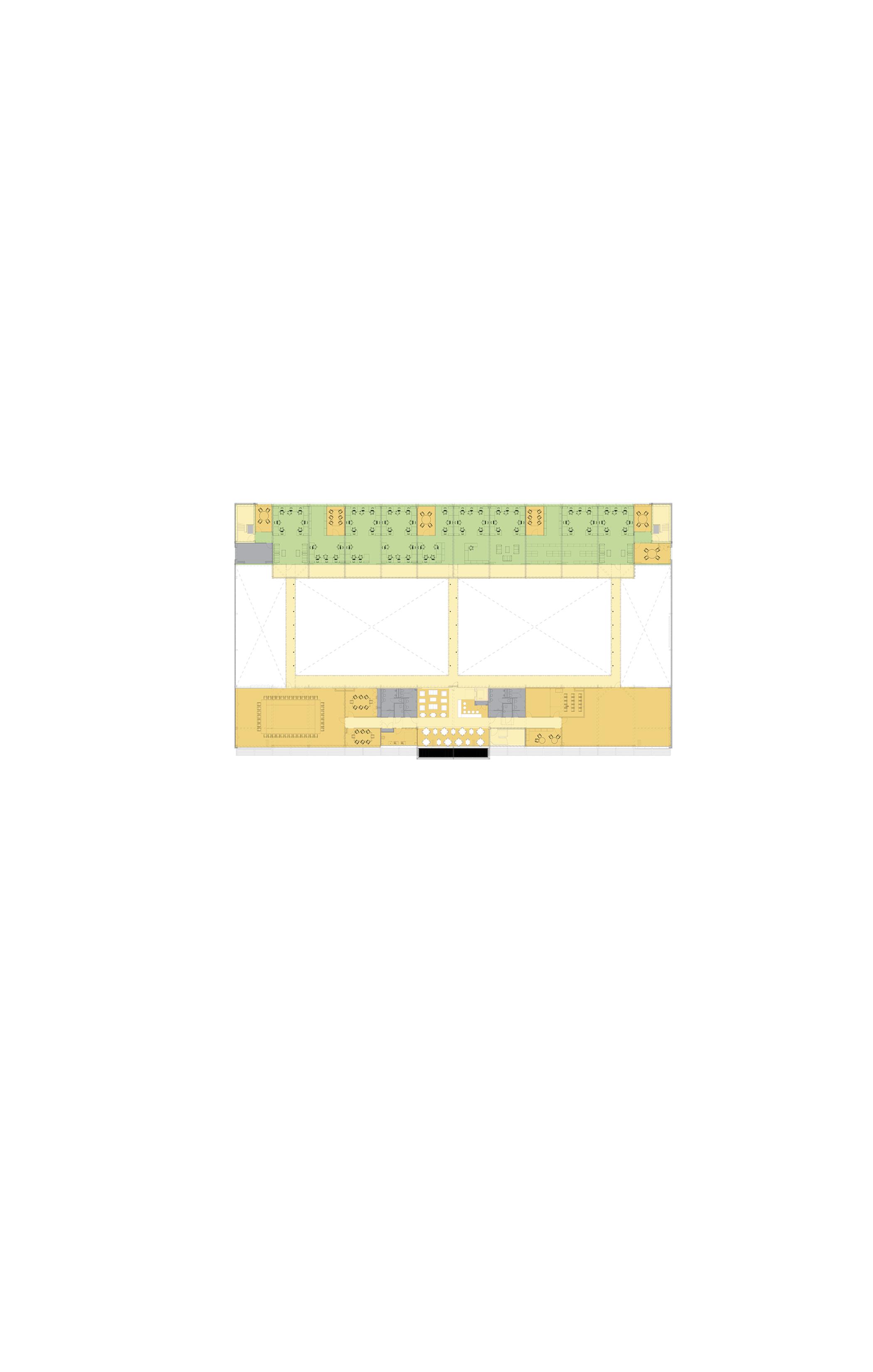
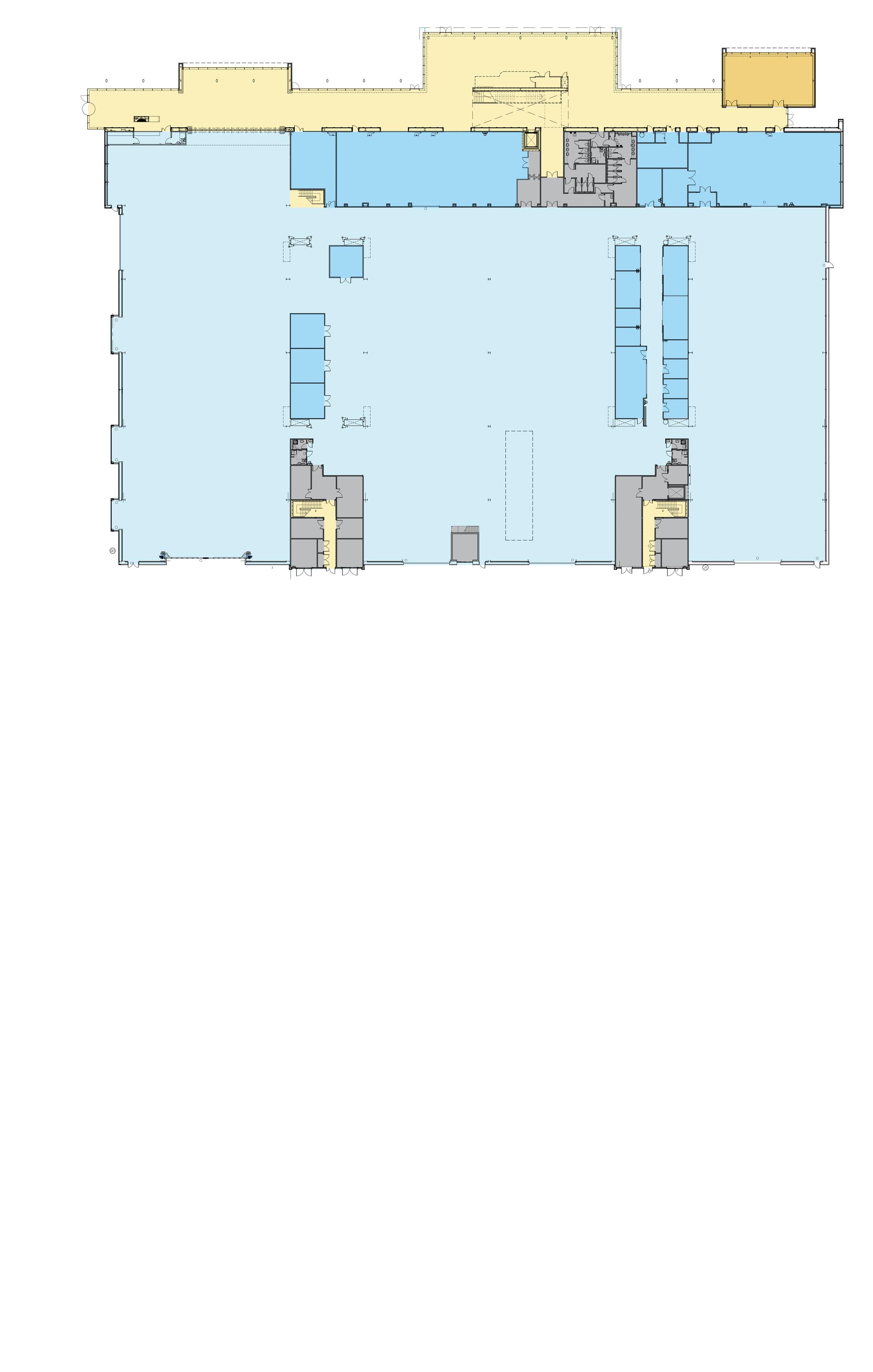
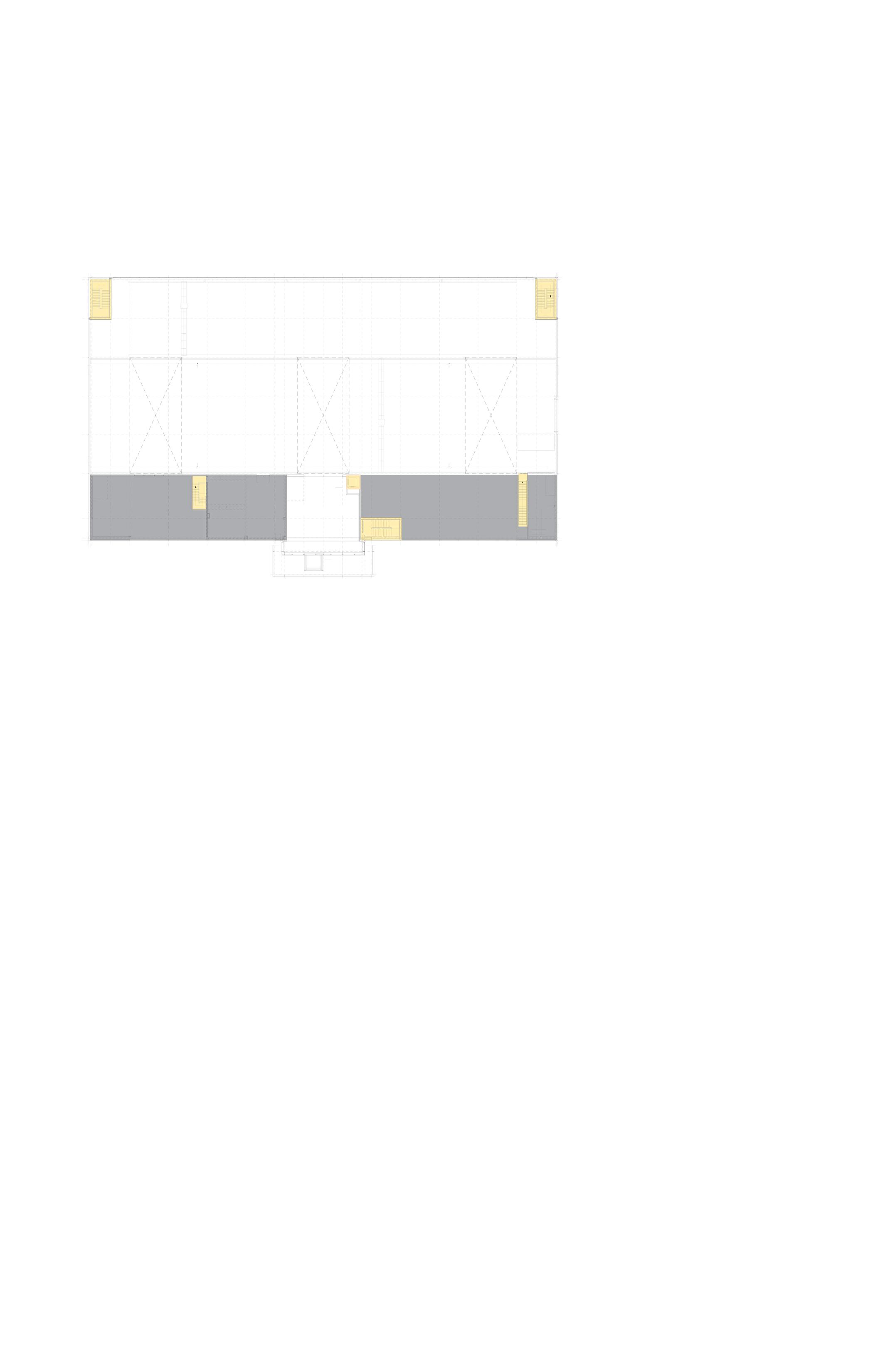
Appendix: Floor Plans of the Centers: AFRC, MTC
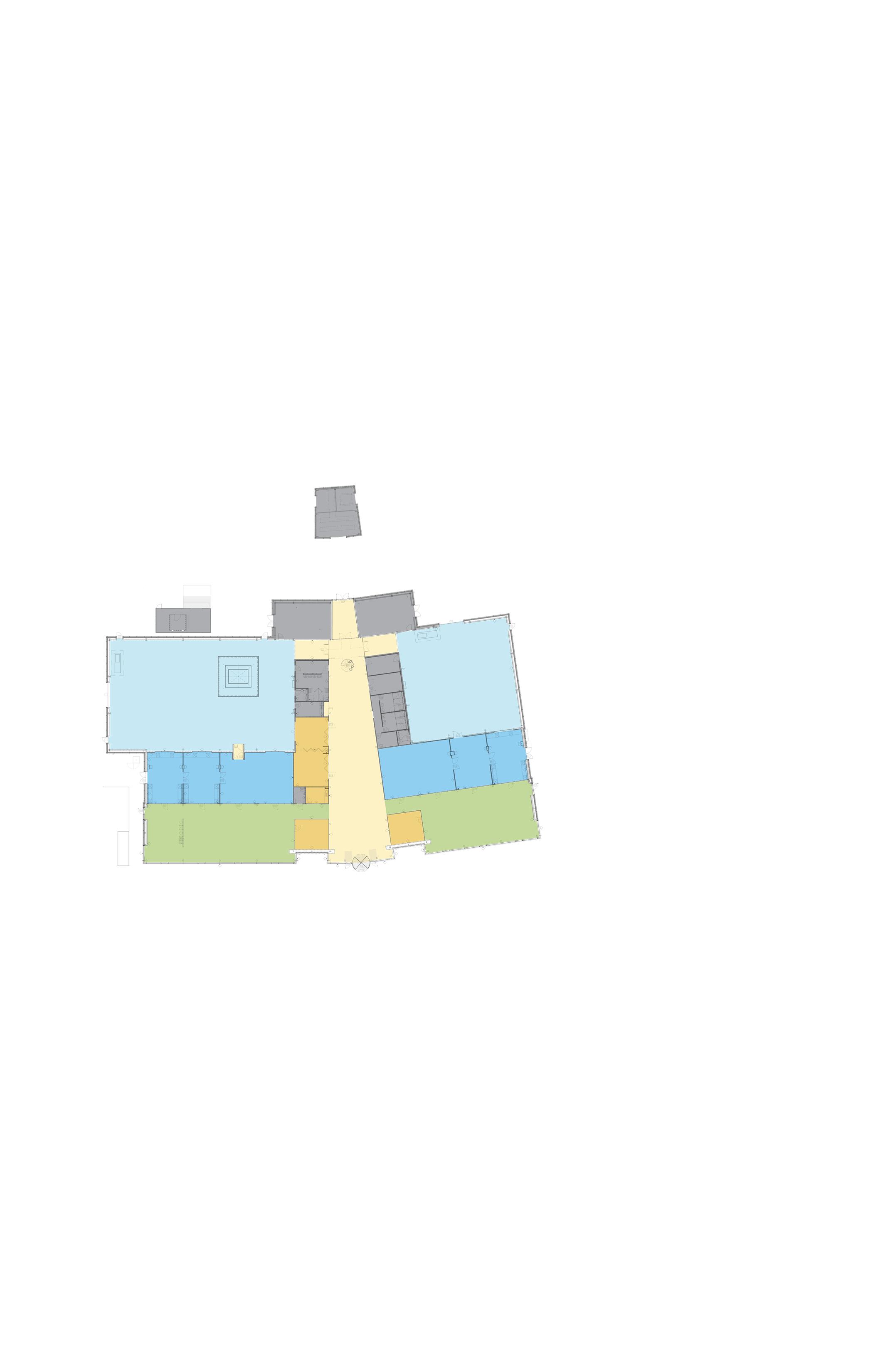

Figure 2: MTC ground floor plan
Appendix: Floor Plans of the Centers: MTC
0
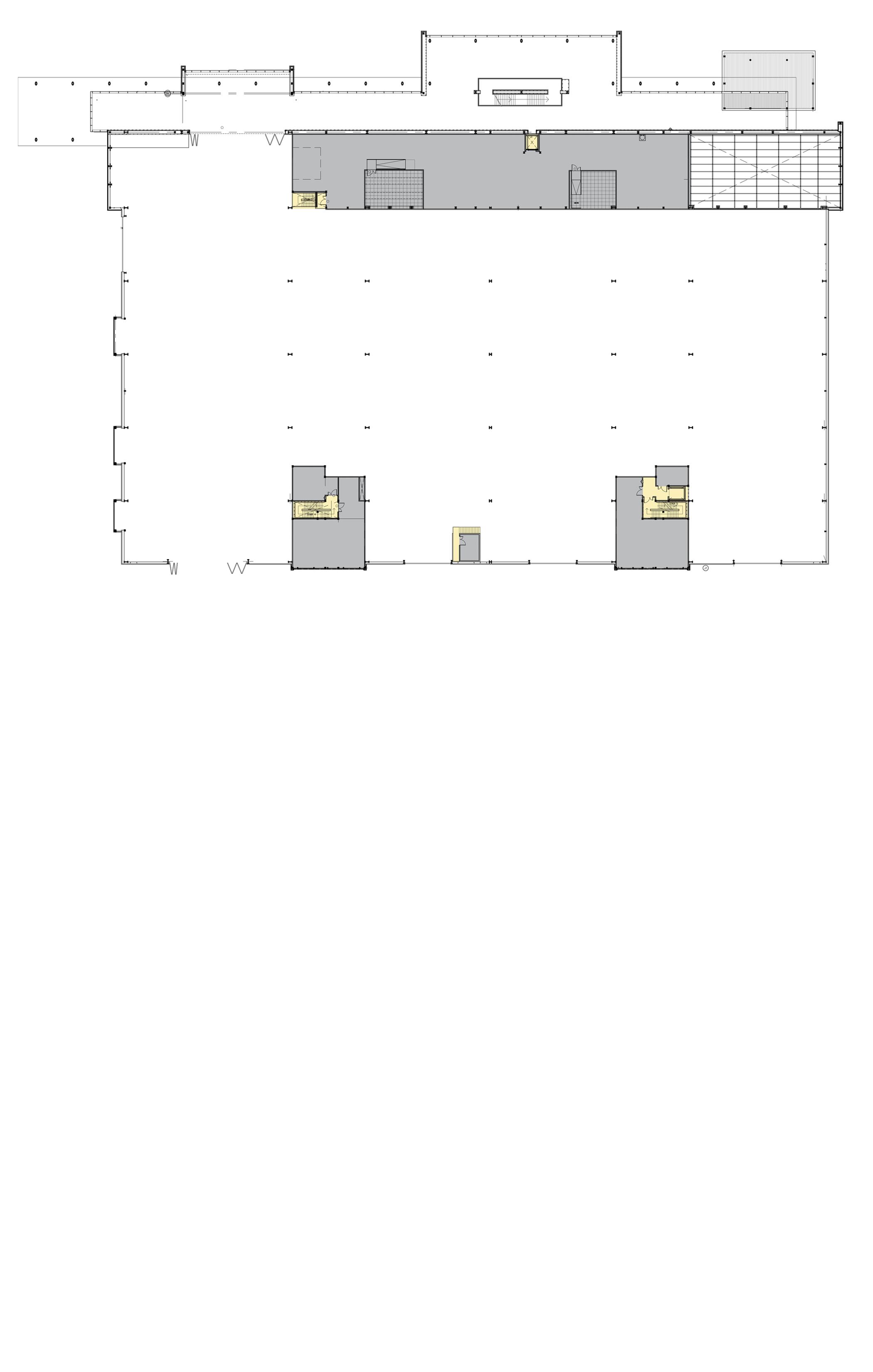
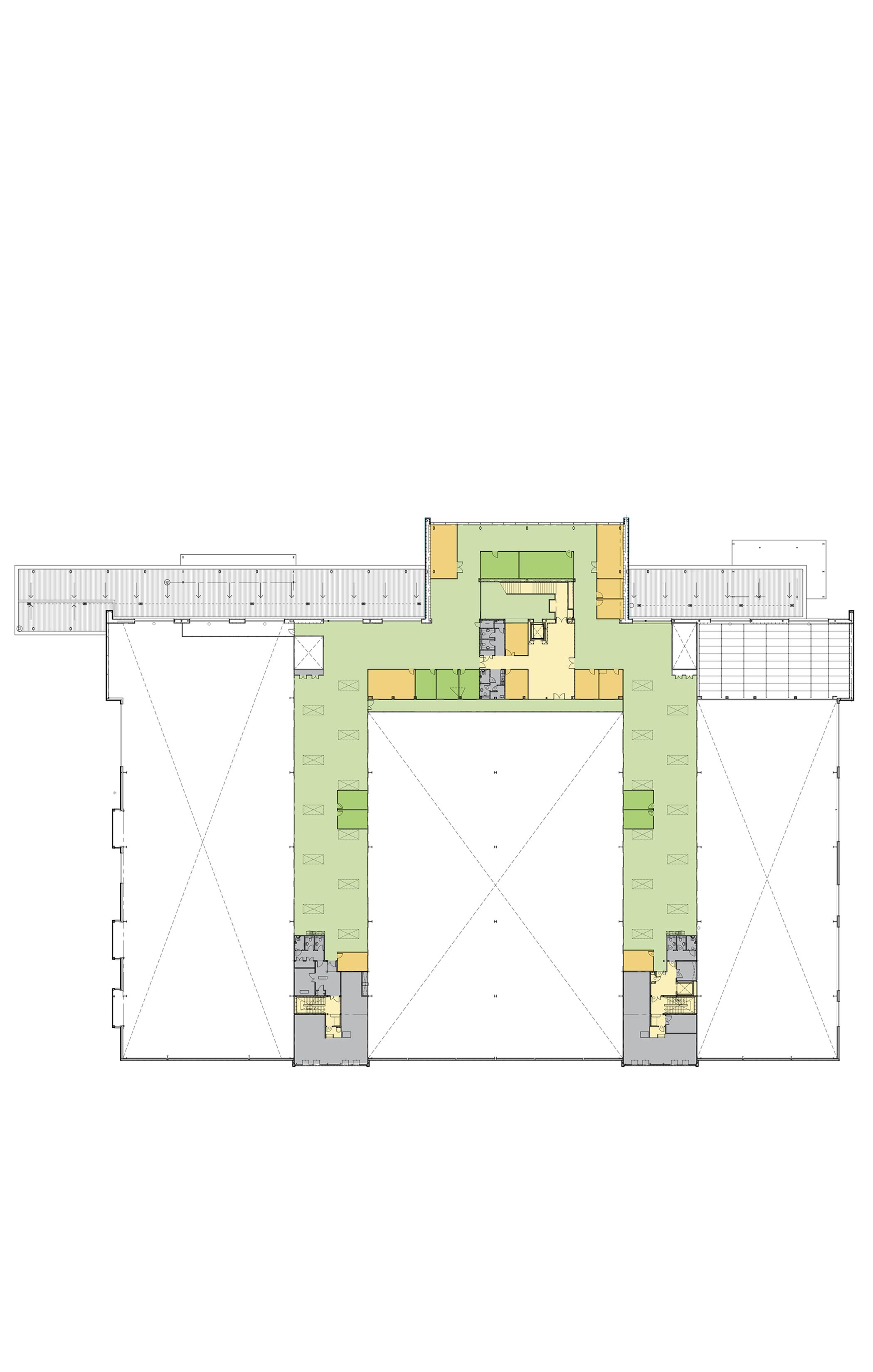
Figure 2: MTC first floor plan
Figure 1: MTC mezzanine floor plan
Appendix: Floor Plans of the Centers: NCC


Figure 1: NCC ground floor plan
Figure 2: NCC first floor plan
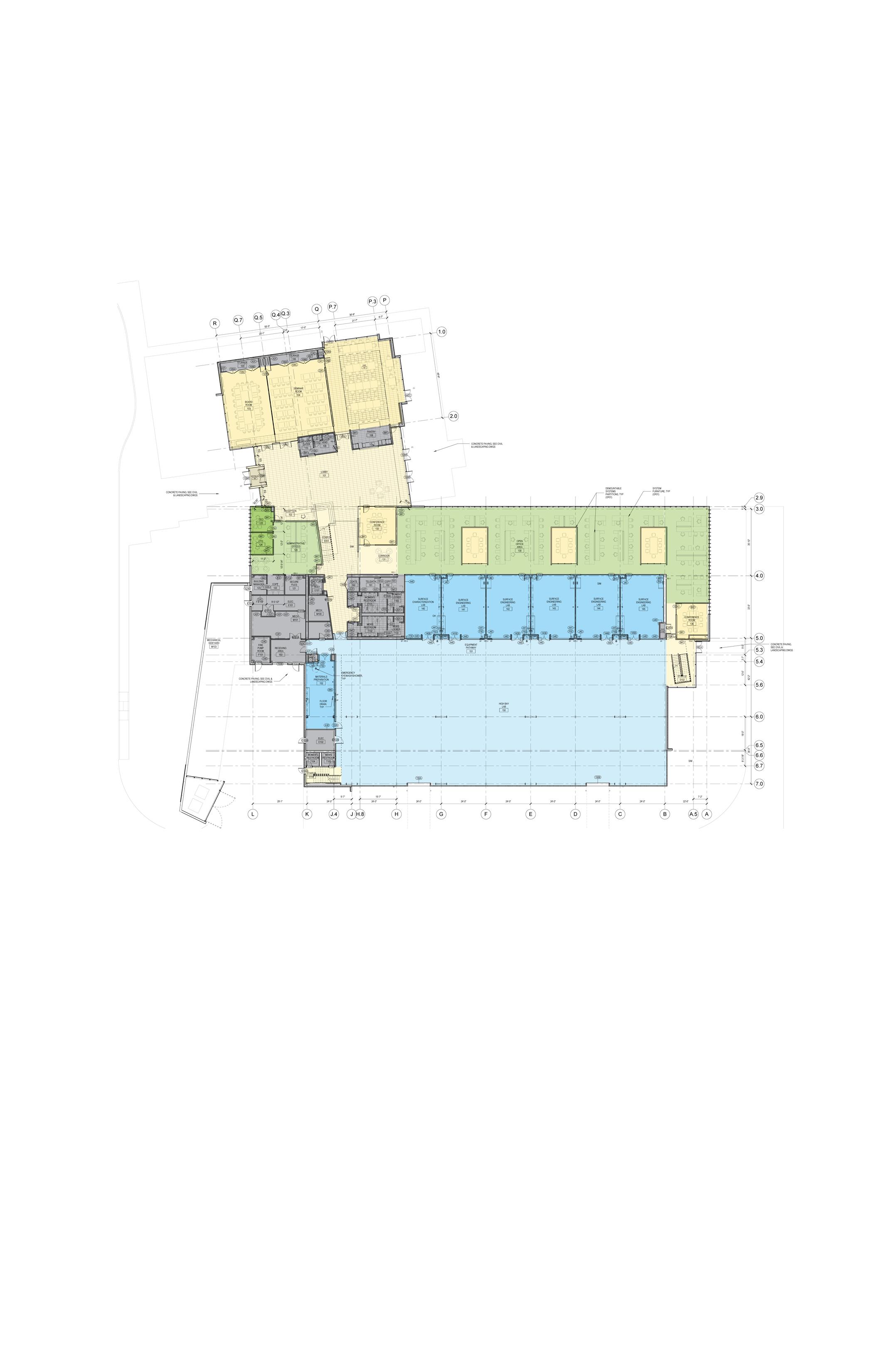
Figure 1: CCAM first floor plan

Figure 2: CCAM second floor plan
Acknowledgements
Acknowledgements

Paul Harney is a managing principal in Perkins&Will’s Washington D.C. studio, specializing in higher education and science and technology projects.
Thanks for the generous time and support afforded to this study are given to:
Advanced Manufacturing Research Centre (AMRC), Sheffield:
• Dr. Keith Ridgway, Director
• John Baragwanath, OBE, Projects Director
• Dr. Rab Scott
• Darren Southgate, Director, Bond Bryan Architects, Sheffield
Manufacturing Technology Centre (MTC), Coventry
• Dr. Clive Hickman, Director
• Steve Statham, Business Development Manager
• Colin Bradley, Facilities/Health & Safety Manager
National Composites Centre (NCC), Bristol
• Dr. Peter Chivers, Chief Executive
• Gary Milliner, Director, Stride Treglown Architects, Bristol
• Paul Cooper, University of Bristol
Advanced Forming Research Centre, Glasgow
• Dr. William Ion, Operations Director
• Guy Maxwell, Director, Hypostyle Architects, Glasgow
Additionally, Taidg O’Malley greatly enriched site visits and interviews by providing perspective and insight of British architectural. Matt Hall, who has provided immeasurable assistance in helping to prepare drawings and graphics for this report.
For more information, contact: paul.harney@perkinswill.com
